Devoted to DNA
It was day two of the three-day International Summit on Human Gene Editing in Washington, D.C. The morning panel discussions, with titles like “Applications of gene editing technology: basic research” and “Applications of gene editing technology: somatic cell therapy” were a long wade through genetics and molecular and cell biology of gene-editing technologies. The National Academies lecture hall was dark and cavernous, and the steady flashing of PowerPoint slides was edging toward numbing.
Then Fyodor Urnov of Sangamo BioSciences got up to speak. In a strong, clear voice, flecked with Russian and British accents, Urnov dissipated the torpor hovering over the lecture hall as he told a story about the biology of inherited blood disorders and how gene editing could be used to tackle them.
 Fyodor Urnov at Sangamo BioSciences is one of the world’s experts in exploiting zincfinger nucleases for gene editing applications. He is also an adjunct faculty member at the University of California, Berkeley.
Image courtesy of Fyodor Urnov
Fyodor Urnov at Sangamo BioSciences is one of the world’s experts in exploiting zincfinger nucleases for gene editing applications. He is also an adjunct faculty member at the University of California, Berkeley.
Image courtesy of Fyodor Urnov
Urnov’s ability to grab audiences goes back to his graduate school days. Recalling Urnov’s presentation at a Cold Spring Harbor meeting in the late 1990s, Jasper Rine at the University of California, Berkeley, says, “Fyodor’s delivery was so articulate, passionate and scientifically interesting that I was just captivated through the entire thing.”
Even on the phone with me, Urnov spoke with a storyteller’s ear, peppering the conversations with references as disparate as Henry David Thoreau and “The Martian.” The man loves to tell a good tale and share what he knows. It doesn’t come as a surprise to find out that in his spare time Urnov teaches undergraduate courses in general biology, biochemistry and genetics at Berkeley.
As a scientist, Urnov has had one molecule in his sights: DNA. His obsession with the molecule stems from James Watson’s book “The Double Helix.” Like many of Urnov’s generation of molecular biologists, reading the book as a preteen led him to decide to dedicate his life to DNA.
Urnov says he now recognizes the book’s flaws, but at the time he had concluded that “DNA is the only thing worth devoting one’s life to.” He adds, “I just can’t really explain why I felt that except that this book lit that fire in me.”
When Urnov began his independent research career at Sangamo in 2000, he delved into understanding how complicated genomes, whether of plants or of humans, can lend themselves to sophisticated tinkering. Along with a Sangamo colleague, Michael Holmes, he coined the phrase “genome editing.” In 2014, Thomson Reuters listed in its compilation of “The World’s Most Influential Scientific Minds.” He was one of the few scientists in industry to make the list.
Back in the USSR
Urnov grew up in Soviet-era Russia in a family of academics that believed in the power of words. His mother is a linguist. His father is a literary critic and a writer. Urnov lived in Moscow, “10 minutes away from the Bolshoi ballet and 10 minutes away from the Moscow Conservatory,” which made him fluent in analogies to Western classical music, although his true musical passion is the Beatles. (“He is a walking encyclopedia of the entire Beatles catalog,” notes Rine.)
His father brought in a steady stream of books. “Books are his trade,” says Urnov. “At all stages of my life, he made sure there were plenty of books for me to read.”
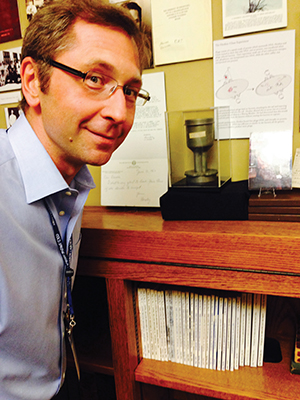 Urnov at Cold Spring Harbor Laboratory in front of the blender used by Alfred Hershey and Martha Chase in a series of experiments conducted in 1952 that helped to confirm DNA as the genetic material.
Image courtesy of Maria Jasin at Memorial Sloan Kettering Cancer Center
Urnov at Cold Spring Harbor Laboratory in front of the blender used by Alfred Hershey and Martha Chase in a series of experiments conducted in 1952 that helped to confirm DNA as the genetic material.
Image courtesy of Maria Jasin at Memorial Sloan Kettering Cancer Center
On Urnov’s 12th birthday, his father gave him “The Double Helix.” Urnov read it as an “incredibly exhilarating narrative of the thrill of scientific discovery,” he says.
For the same birthday, an aunt gifted him a microscope. Urnov immediately used it to examine the antennae of a crawling insect he caught on the dining table. He was awestruck by the ridges he saw on the tiny antennae. “It was a bolt-of-lightning moment of how extraordinary life is when you look at it closely,” he says.
With those two gifts, his calling to biology coalesced. Urnov says he was very fortunate to attend Moscow State University for his undergraduate degree in biology, learning the fundamentals of botany and zoology, which later came in handy as he worked on different animals and plants over the course of his research.
His other good fortune was timing: “(Mikhail) Gorbachev came into power and then (Boris) Yelstin came into power and dissolved the Soviet Union,” says Urnov. “The Iron Curtain fell.”
Once it did, the United States, with its biomedical research enterprise, beckoned. “So I applied to graduate schools in the States and went to Brown (University), bright-eyed and bushy-tailed,” he says.
Urnov joined the laboratory of Susan Gerbi, where he began to make his mark as a researcher, teacher and public speaker. Gerbi, who is unabashedly proud of her protégé, says that Urnov excelled during his research to identify locations for DNA amplification initiation in the chromosomes of a fly called Sciara: “He was a model graduate student in terms of looking up the literature about methods that he was employing and seeking out advice from other faculty in the department who were using that methodology,” she says, adding that Urnov won a prize for his work in molecular biology when he graduated.
Gerbi also watched an aptitude for teaching emerge in Urnov. Every Brown graduate student does a year of assistant teaching. Urnov helped with a cell biology course Gerbi co-taught with Kenneth Miller.
Urnov “is dynamite in a classroom,” says Gerbi. “The students, in their course evaluations, wrote that he should be given tenure as a graduate TA and kept at Brown forever! They thought he was so fabulous.” Upon graduation, Urnov received a presidential award for his teaching from Brown.
Also in graduate school, Urnov displayed a knack for keeping the soporific effects of scientific presentations at bay. Gerbi still remembers a Cold Spring Harbor meeting where Urnov was scheduled to give a talk during the unfortunate 10:30 p.m. slot. As the evening wore on, “people were starting to doze off,” recalls Gerbi. But when Urnov got up to speak, “everybody woke up and got so turned on by his talk.”
She says the speaker who followed Urnov got up and said, “Who am I to try and sing after the great Caruso has just performed an aria?”
Targeting specific genes
After getting his Ph.D. in the late 1990s, Urnov moved down the East Coast to Bethesda, Md., to join the laboratory of Alan Wolffe at the National Institutes of Health as a postdoctoral fellow. There, he continued to work with DNA, this time in the form of chromatin and nuclear hormone receptors in frog cells.
But his postdoctoral stint at the NIH was short. Sangamo recruited Wolffe to be its chief scientific officer, so Urnov moved with him to the company’s headquarters in the San Francisco Bay area in 2000. (In 2001, Wolffe died from injuries sustained in a traffic accident while attending a meeting in Rio de Janeiro.)
Urnov’s first task at Sangamo was to see if there was a means to edit DNA in a specific, targeted way and not rely on the standard method of the time, which was random integration of genes based on homologous recombination and a healthy dose of luck.
In a 2005 Nature paper, the Sangamo team, led by Holmes and Urnov, described how special zinc finger nucleases engineered to recognize a specific position could correct mutated genes in human cells. As proof of concept, they corrected the gene for severe combined immune deficiency in cultured human cells with an efficiency that would pass muster for clinical applications. Researchers took note. “My inbox started to fill up with requests for collaboration,” says Urnov.
One request for collaboration came from the agriculture company Dow Agrosciences. About “90 percent of cotton, soybean and corn grown in North America is genetically engineered. But genetic engineering, since its invention in the 1970s, has relied on the random integration of external genetic material,” says Urnov. “It’s time-consuming and labor-intensive. It takes 10 years to go from wanting to have a corn plant that carries a desired gene to when you can commercialize that plant.”
Dow Agrosciences wanted to see if engineered zinc finger nucleases could speed up genetic engineering. Eventually, the team of Dow and Sangamo scientists showed that it could engineer zinc finger nucleases that gave a two-for-one deal. The nucleases were capable of pushing out an undesirable trait in a plant — such as a gene for a chemical that acted as an environmental pollutant when consumed by livestock — and replacing it with a desirable trait, such as herbicide resistance, in a single shot. The technology worked so well that Dow Agrosciences licensed it from Sangamo.
By this point it was the late 2000s and the requests for engineered zinc finger nucleases were getting overwhelming. Something had to be done, so Sangamo partnered with Sigma–Aldrich, one of the world’s largest suppliers of chemical and biological reagents.
The goal was to scale up synthesis of many different types of engineered zinc finger nucleases so that researchers around the world could order them as easily as they would order oligonucleotides. The project, which consumed a little more than two years of Urnov’s life after he finished working on the Dow partnership, resulted in a technology that Sangamo ultimately licensed to Sigma–Aldrich. It’s now Sigm–Aldrich’s CompoZr brand.
DNA as a druggable target
Urnov’s focus now is back on humans, this time on actual patients. In collaboration with Biogen, Sangamo is working out how to treat two blood diseases, beta-thalassemia and sickle-cell disease. In the U.S., the Centers for Disease Control and Prevention estimates that 1,000 people have beta-thalassemia. It is most common among people of Mediterranean descent and also is found in people from Southeast Asia, the Arabian Peninsula, Iran, Africa and Southern China. Currently, the only way to cure someone of the disease is to do a bone marrow transplant.
The CDC estimates that there are 90,000 to 100,000 Americans with sickle-cell disease, which also can be cured only with a bone marrow transplant. But “the public health burden worldwide from these diseases is severe,” says Urnov. According to a 2006 report in the journal Bone Marrow Transplantation, blood transfusions and drugs to treat beta-thalassemia in Taiwan, a country that has hundreds of patients, can cost the national healthcare system hundreds of thousands of dollars per patient.
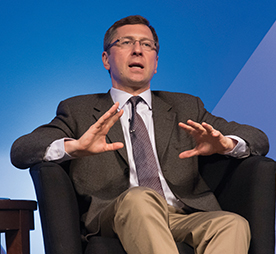 Urnov gave a talk at the International Summit on Human Gene Editing at the National Academies in December.
Image courtesy of the National Academy of Sciences
Urnov gave a talk at the International Summit on Human Gene Editing at the National Academies in December.
Image courtesy of the National Academy of Sciences
In both of these inherited diseases, the gene for making beta-hemoglobin is disrupted. In beta-thalassemia, there is little or no beta-hemoglobin made; in sickle-cell disease, the mutant beta-hemoglobin causes the erythrocytes to take on an abnormal sickle shape.
So the team at Sangamo and Biogen is tackling the diseases by using genome editing with zinc finger nucleases in certain stem cells taken from patients. The cells are tweaked to make fetal hemoglobin instead, and they are put back into the patients to increase the production of fetal hemoglobin. Making fetal hemoglobin decreases the severity of the disease. Urnov says that the U.S. Food and Drug Administration has given the go-ahead to test the safety, tolerability and potential efficacy of another approach of using zinc finger nucleases to treat adults with a form of hemophilia.
Urnov marvels at how quickly the fundamental research into the biology of these diseases has made its way into the clinic. He points out that the therapeutic strategy developed by Sangamo and Biogen is based on findings from a genomewide association study done in the late 2000s. “A study dissecting, to a finer resolution, the mechanism of how the genetic circuit plays itself out to protect people from sickle and beta-thal was only published in 2013,” he says. “And here we are.”
Urnov also drives home the point that gene-editing technologies have changed dramatically the way researchers can approach the development of therapeutic strategies, a point he also emphatically made at the National Academy of Sciences summit in December. “The invention of genome editing expanded the definition of the term ‘druggable target.’ Once upon a time, classical targets were things like enzymes,” says Urnov. “Today we can drug something that’s directly in the DNA.”
‘A tremendous sense of drama’
Despite all he does at Sangamo, Urnov has not let go of his passion for teaching. Shortly after Urnov joined Sangamo in 2000, it just so happened that Rine’s department at Berkeley had a lecturer bail on a section of an undergraduate biology course. No one on staff could fill the hole. Rine suggested that Urnov be the replacement. “The rest, as they say, is history,” says Rine.
Urnov now holds an adjunct faculty position in the molecular and cell biology department. “On top of his more-than-full-time job with Sangamo, he volunteers to put up with the ridiculous driving in the Bay Area and then the even more ridiculous parking near campus, all for the privilege of working hard for us to teach as many as 600 smiling faces at 8 o’clock in the morning,” Rine says.
Urnov views teaching as an endeavor from which he stands to gain as much as his students.
“In order to teach something, you have to understand it incredibly well,” he says. Teaching “infuses me with an appreciation for the grandeur of our discipline and a respect for how much there is to know and how much the little details matter.”
Rine, who pairs up with Urnov to teach an undergraduate biology class for nonmajors, says he enjoys watching Urnov teach. “He has a wonderful old-world charm and a beautiful capacity to weave the historical narrative along with the fundamentals of the experiments in a way that provides context in which to understand things,” he says. Urnov imparts “a tremendous sense of drama such that while hearing about experiments, you can imagine being in the lab and watching the data appear before your eyes.”
Urnov also relishes the challenge of connecting with younger adults. “Nothing beats taking 100 Berkeley undergrads who feel themselves to be slightly jaded and getting them to be excited about Gregor Mendel’s or Thomas Hunt Morgan’s experiments in the pea and the fruit fly,” he says.
Urnov sums his enthusiasm for teaching and for his work on editing DNA by saying, “It’s just intellectually exhilarating.”
Enjoy reading ASBMB Today?
Become a member to receive the print edition four times a year and the digital edition monthly.
Learn moreGet the latest from ASBMB Today
Enter your email address, and we’ll send you a weekly email with recent articles, interviews and more.
Latest in Industry
Industry highlights or most popular articles

How Alixorexton could transform narcolepsy treatment
A new investigational drug, alixorexton, targets the brain’s orexin system to restore wakefulness in people with narcolepsy type 1. Alkermes chemist Brian Raymer shares how molecular modeling turned a lab idea into a promising phase 3 therapy.

Inside industry postdocs
As more Ph.D. scientists look beyond academia, industry postdocs offer a new kind of training, where mentorship meets mission-driven research. Fellows at Pfizer and Genentech share how these programs prepare them to translate discovery into impact.

Black excellence in biotech: Shaping the future of an industry
This Black History Month, we highlight the impact of DEI initiatives, trailblazing scientists and industry leaders working to create a more inclusive and scientific community. Discover how you can be part of the movement.
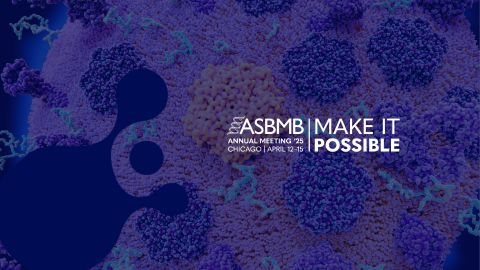
Attend ASBMB’s career and education fair
Attending the ASBMB career and education fair is a great way to explore new opportunities, make valuable connections and gain insights into potential career paths.
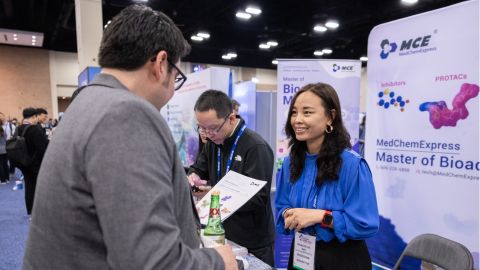
Benefits of attending a large scientific conference
Researchers have a lot of choices when it comes to conferences and symposia. A large conference like the ASBMB Annual Meeting offers myriad opportunities, such as poster sessions, top research talks, social events, workshops, vendor booths and more.
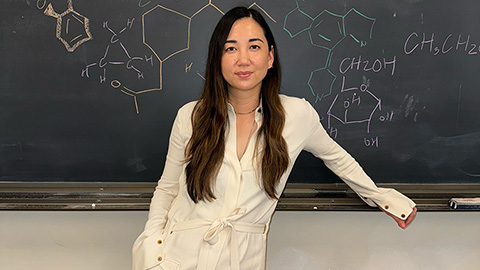
Biotech startup worms its way into therapeutics
Andrea Choe's company, Holoclara, has created an anti-inflammatory drug based on a molecule from worms.

